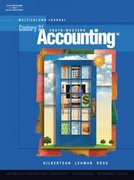Answered step by step
Verified Expert Solution
Question
1 Approved Answer
Classify each of these items as an asset (A), liability (L), or stockholders equity (SE). _____ a. Accounts receivable _____ b. Accounts payable _____ c.
Classify each of these items as an asset (A), liability (L), or stockholders equity (SE). _____ a. Accounts receivable _____ b. Accounts payable _____ c. Common stock _____ d. Office supplies _____ e. Retained earnings _____ f. Cash _____ g. Note payable _____ h. Equipment True/False Questions 1. _____The cash basis of accounting is not in accordance with generally accepted accounting principles. 2. _____Adjusting entries are often made because some business events are not recorded as they occur. 3. _____Accrued revenues are revenues that have been earned but not yet received. 4. _____Internal control is most effective when several people are responsible for a given task. 5. _____A liability is classified as a current liability if it is to be paid within the coming year. 6. _____The excess of current assets over current liabilities is called working capital. 7. _____The current ratio takes into account the composition of current assets. 8. _____Generally accepted accounting principles are rules and practices that are recognized as a general guide for financial reporting purposes. 9. _____GAAP stands for generally accepted accounting procedures. 10. _____Consistency in accounting means that a company uses the same generally accepted accounting principles from one accounting period to the next accounting period. Multiple Choice Questions 11. _____An accounting time period that is one year in length is called: a. a fiscal year. b. an interim period. c. the time period assumption. d. a reporting period. 12. _____The matching principle matches: a. customers with businesses. b. expenses with revenues. c. assets with liabilities. d. creditors with businesses. 13. _____Two of the major characteristics that make accounting information useful are a. Relevance and reliability. b. Verifiability and timeliness. c. Comparability and flexibility. d. Understandability and consistency. 14. _____Under the accrual basis of accounting: a. cash must be received before revenue is recognized. b. net income is calculated by matching cash outflows against cash inflows. c. events that change a company's financial statements are recognized in the period they occur rather than in the period in which cash is paid or received. d. the ledger accounts must be adjusted to reflect a cash basis of accounting before financial statements are prepared under generally accepted accounting principles. 15. _____A small company may be able to justify using a cash basis of accounting if they have: a. sales under $1,000,000. b. no accountants on staff. c. few receivables and payables. d. all sales and purchases on account. 16. _____The general term employed to indicate an expense that has not been paid or revenue that has not been received and has not yet been recognized in the accounts is: a. contra asset. b. prepayment. c. asset. d. accrual. 17. _____The cost of assets consumed or services used is also known as a. a revenue. b. an expense. c. a liability. d. an asset. 18. _____Internal controls are concerned with a. only manual systems of accounting. b. the extent of government regulations. c. safeguarding assets. d. preparing income tax returns. 19. _____In a classified balance sheet, assets are usually classified as: a. current assets; long-term assets; property, plant, and equipment; and intangible assets. b. current assets; long-term investments; property, plant, and equipment; and common stocks. c. current assets; long-term investments; tangible assets; and intangible assets. d. current assets; long-term investments; property, plant, and equipment; and intangible assets. 20. _____The current ratio is a. current assets plus current liabilities. b. current assets minus current liabilities. c. current assets divided by current liabilities. d. current assets times current liabilities. 21. _____Working capital is calculated by taking a. current assets plus current liabilities. b. current assets minus current liabilities. c. current assets divided by current liabilities. d. current assets times current liabilities. 22. _____Long-term creditors are usually most interested in evaluating a. liquidity and profitability. b. consistency and profitability. c. liquidity and solvency. d. consistency and solvency. 23. _____Which of the following financial statements is divided into major categories of operating, investing, and financing activities? a. The income statement. b. The balance sheet. c. The retained earnings statement. d. The statement of cash flows. Problems 24. Use the following data to calculate the current ratio. Koonce Office Supplies Balance Sheet December 31, 2010 Cash $ 65,000 Accounts Payable $ 70,000 Prepaid Insurance 30,000 Salaries Payable 10,000 Accounts Receivable 50,000 Mortgage Payable 80,000 Inventory 70,000 Total Liabilities $160,000 Land held for Investment 75,000 Land 90,000 Building $100,000 Common Stock $120,000 Less Accumulated Retained Earnings 250,000 Depreciation (20,000) 80,000 Total Stockholders Equity $370,000 Trademark 70,000 Total Liabilities and Total Assets $530,000 Stockholders Equity $530,000 a. 1.94 : 1. b. 1.57 : 1. c. 3.14 : 1. d. 2.69 : 1. 25. Given the following adjusted trial balance: Debit Credit Cash $1,562 Accounts receivable 2,098 Inventory 3,124 Prepaid rent 86 Property, plant & equipment 300 Accumulated depreciation 52 Accounts payable 82 Unearned revenue 122 Common stock 206 Retained earnings 6,610 Service revenue 268 Interest revenue 56 Salary expense 160 Travel expense 66 Total $7,396 $7,396 Net income for the year is: a. $98 b. $270 c. $324 d. $496
Step by Step Solution
There are 3 Steps involved in it
Step: 1

Get Instant Access to Expert-Tailored Solutions
See step-by-step solutions with expert insights and AI powered tools for academic success
Step: 2

Step: 3

Ace Your Homework with AI
Get the answers you need in no time with our AI-driven, step-by-step assistance
Get Started


